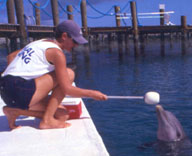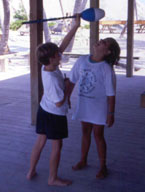How Do You Do That?
 A Trainer Asks A Dolphin To Target.
A Trainer Asks A Dolphin To Target.
One of the most commonly asked questions at Dolphin Encounters is: How
do you train the dolphins? In technical terms, we train our animals
with a system of positive reinforcement through operant conditioning.
In simpler terms, we break down the steps of each behavior and train
them one at a time. Trainers teach each step by having the dolphin
follow an object we call a target.
We use five tools in this method. The first tool, the hand signal,
tells the animal which behavior the trainer wants them to do. The
target, which can be any object, tells that animal how and where to do
the behavior. The whistle tells the animal when it has done a behavior
correctly. When the animal does something correct, they receive a
reward. Rewards come in many shapes and sizes, such as food, toys,
attention, or an animated response from the trainer. Each correct step
leads towards the goal of the finished behavior.
When
the animal does something incorrect, they receive a neutral response or
a time-out for at least five seconds. This gives the animal time to
think about what it did incorrectly so that it knows not to try that
behavior again in the future. The timeout also gives the trainer time
to figure out what the problem was and how to set up the animal to
succeed the next trial.
 A student target trains his friend.
A student target trains his friend.
But why would the dolphin want to follow a target? Simple: we teach the
dolphin that if it follows the target correctly it will get a reward.
The first behavior we actually train is targeting. We place a target,
such as a small float on the end of a pole, on the dolphin's rostrum,
blow the whistle and give the animal a reward. We repeat this several
times. The next time, we place the target a short distance form the
dolphin's rostrum and wait. Because the animal has been rewarded for
touching it in the past, the animal makes the mental leap and moves to
touch it on his own.
Now that we have trained our dolphin to target, we can train any
behavior. Trainers use their hands (and sometimes target poles) to help
guide an animal's movement and direction. A signal is incorporated at
the very beginning of the training to denote that particular behavior.
Each behavior must be given a new distinct signal so as not to confuse
the animal with something it may already know.
Putting the signal in right at the start of the training has a few
benefits. It allows the animal to link all the steps it knows for one
behavior to one signal. It allows the animal then to show the trainer
what it knows well and the trainer can then add the next step. Finally,
the signal allows the dolphin to work on different behaviors with
different trainers instead of learning only one behavior at a time. By
the time the trainer gets to the last step in the training, the animal
will be able to do the whole behavior just on the signal alone.
Completed behaviors can take as little as a few sessions or as many as a few months to train. Once finished, the primary trainer will then go over the correct signal and corresponding criteria with secondary trainers. This is done to ensure the animal's comprehension of the behavior, but also to eliminate the acceptance of substandard criteria.

